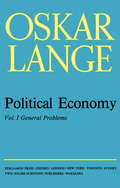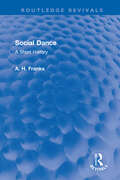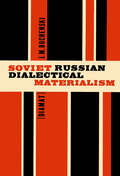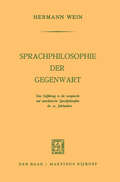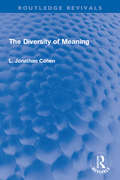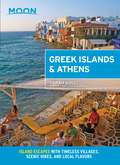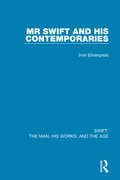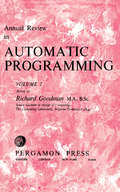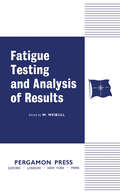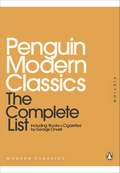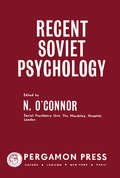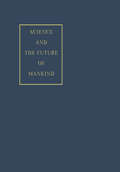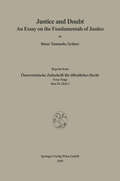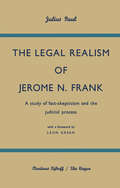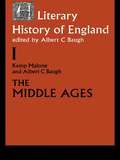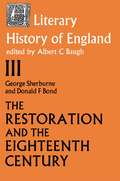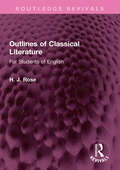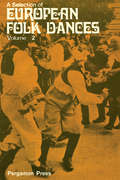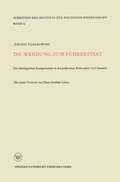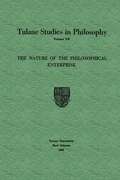- Table View
- List View
General Problems: Political Economy
by Oskar LangePolitical Economy, Volume I: General Problems provides a systematic treatise on political economy. This book discusses the state of economic science and the course of economic development in different parts of the world. Organized into seven chapters, this volume begins with an overview of the social or political economy as the study of social laws governing the production and distribution of the material means of satisfying human needs. This text then examines the basic regularity encountered by political economy in its analysis of the social laws governing human economic activity, which is formed by the dependence of production relations on social productive forces. Other chapters consider the objective character of economic laws. This book discusses as well the concern of economic history in the development of concrete economic progress. The final chapter deals with the differences of opinions and interpretations in the development of science. Economists will find this book useful.
Social Dance: A Short History (Routledge Revivals)
by Arthur FranksOriginally published in 1963 and authored by the then Editor of the Dancing Times, this was a pioneer work discussing not only the origins and development of many social dance forms from early times, but also relating these forms to their environment. As well as its role in social history, the book analyses the role of dance as a prime creative power in Renaissance spectacles which depicted and celebrated diplomatic, military and regal occasions. After a wide-ranging introductory chapter on the origins of dancing, the book takes the reader through the centuries, discussing in turn the Basse Danse and the Moresco of the Middle Ages, the Pavane, Galliard and Courante of the 16th Century, the Minuet of the 17th & 18th, the Allemande, the Waltz and the Polka as well as Jazz, the Cha Cha Cha, the Jive and Twist.
Social Dance: A Short History (Routledge Revivals)
by Arthur FranksOriginally published in 1963 and authored by the then Editor of the Dancing Times, this was a pioneer work discussing not only the origins and development of many social dance forms from early times, but also relating these forms to their environment. As well as its role in social history, the book analyses the role of dance as a prime creative power in Renaissance spectacles which depicted and celebrated diplomatic, military and regal occasions. After a wide-ranging introductory chapter on the origins of dancing, the book takes the reader through the centuries, discussing in turn the Basse Danse and the Moresco of the Middle Ages, the Pavane, Galliard and Courante of the 16th Century, the Minuet of the 17th & 18th, the Allemande, the Waltz and the Polka as well as Jazz, the Cha Cha Cha, the Jive and Twist.
Soviet Russian Dialectical Materialism [Diamat]
by J. M. BochenskiThis book offers a critical outline of the sources of the history, of the spirit and of the doctrines of present-day Soviet Russian Dialectical Materialism ('Diamat'), i.e. of the philosophical foundations of Marxism Leninism. It is scarcely necessary to stress the usefulness of a short outline of this kind, as Russian sources are not easily accessible in the West and as it is of considerable interest to know the doctrines which make up the faith of the Communists* in all countries. The material for this book was first made public in a series of lectures at the University of Fribourg (Switzerland), first in French in the summer term of 1949, later in English at the Summer School in the same year. The French text, slightly expanded, was translated into German by Miss M. Hoerkens, Dipl. rer. pol. Various imperfections in the wording of the text and in the bibliography can be explained by the process of formation of this book. The author hopes that such imperfections will not prove disturbing.
Sprachphilosophie der Gegenwart: Eine Einführung in die Europäische und Amerikanische Sprachphilosophie des 20. Jahrhunderts
by Hermann WeinThe Diversity of Meaning (Routledge Revivals)
by L. Jonathan CohenFirst published in 1962, The Diversity of Meaning was written to provide a more constructive criticism of the philosophy of ordinary language than the more destructive approach that it was commonly subjected to at the time of publication. The book deals with a range of philosophical problems in a way that cuts underneath the more typical orthodoxies of the time. It is concerned primarily with the concept of meaning and asks not just how people ordinarily speak or think about meanings, but also what is gained or lost by their so doing. The author challenges the assumption that there is only one way of talking about meanings and instead argues that no single analysis of meaning can suit the semantics of lexicographers, language-teachers, translators, logicians, historians of ideas, psychologists and philosophers. By examining various common concepts of meaning and their relations to one another, the book sheds light on the issues most alive in philosophical controversy at the time of publication, giving it lasting relevance for those interested in the history of philosophical thought and theory.
The Diversity of Meaning (Routledge Revivals)
by L. Jonathan CohenFirst published in 1962, The Diversity of Meaning was written to provide a more constructive criticism of the philosophy of ordinary language than the more destructive approach that it was commonly subjected to at the time of publication. The book deals with a range of philosophical problems in a way that cuts underneath the more typical orthodoxies of the time. It is concerned primarily with the concept of meaning and asks not just how people ordinarily speak or think about meanings, but also what is gained or lost by their so doing. The author challenges the assumption that there is only one way of talking about meanings and instead argues that no single analysis of meaning can suit the semantics of lexicographers, language-teachers, translators, logicians, historians of ideas, psychologists and philosophers. By examining various common concepts of meaning and their relations to one another, the book sheds light on the issues most alive in philosophical controversy at the time of publication, giving it lasting relevance for those interested in the history of philosophical thought and theory.
Moon Greek Islands & Athens: Island Escapes with Timeless Villages, Scenic Hikes, and Local Flavors (Travel Guide)
by Moon Travel Guides Sarah SouliSoak up the sun, dance till dawn, hike through wild forests, or explore Greek history: Escape to the Mediterranean with Moon Greek Islands & Athens. Choose the right islands for you, with strategic itineraries for different timelines, budgets, and activities, whether you want to lounge on the best beaches, linger in ancient villages, explore the outdoors, or island-hop for a little taste of everythingFocused coverage of Athens and 18 Greek islands, including Santorini, Mykonos, Karpathos, Corfu, Lefkada, and moreUnique experiences and must-see highlights: Marvel at Oia's picturesque blue and white architecture or take a boat to the birthplace of Apollo and Artemis. Soak in therapeutic hot springs, hike through lush forests to waterfalls in Samothrace, or hop aboard a boat and discover hidden coves and wild beaches. Learn about local folklore in Olympos, explore Athens' contemporary galleries and ancient ruins, and savor authentic Greek cuisine, from roasted lamb and olives to dakos and fiery shots of ouzo Insight from Athens local Sarah Souli on how to experience Greece like an insider, support local businesses, and avoid over-tourismFull-color photos and detailed maps throughoutBackground information on the landscape, history, and cultural customs of Greece and each individual islandHandy tools and practical necessities like advice on getting there and getting around, and tips for solo women travelers, seniors, visitors with disabilities, LGBTQ+ travelers, and families with kidsIn-depth coverage of: Athens, Santorini, Mykonos, Folegandros, Milos, Naxos, Anafi, Karpathos, Rhodes, Kalymnos, Samothrace, Ikaria, Lesvos, Alonnisos, Skyros, Corfu, Zakynthos, Lefkada, and CreteWith Moon's practical tips and local know-how, you can experience the best of Athens and the Greek islands.Exploring more of Europe? Check out Moon Rome, Florence & Venice, Moon Prague, Vienna, & Budapest, or Moon French Riviera.
Swift: Volume One: Mr Swift and his Contemporaries (Swift: The Man, his Works, and the Age)
by Irvin EhrenpreisFirst published in 1962, Mr Swift and his Contemporaries, is the first of three volumes providing a detailed exploration of the events of Swift’s life. This volume is a thorough insight into the historical and social setting of Swift’s life, the evolution of his character, and the composition and interpretation of his works. It includes a wealth of material concerning Swift’s family and career, his emotional and sexual life, his relationship with Sir William Temple, and the design and meaning of both A Tale of a Tub and The Battle of the Books. Mr Swift and his Contemporaries is ideal for anyone with an interest in Swift’s life, work, and the period in which he lived.
Swift: Volume One: Mr Swift and his Contemporaries (Swift: The Man, his Works, and the Age)
by Irvin EhrenpreisFirst published in 1962, Mr Swift and his Contemporaries, is the first of three volumes providing a detailed exploration of the events of Swift’s life. This volume is a thorough insight into the historical and social setting of Swift’s life, the evolution of his character, and the composition and interpretation of his works. It includes a wealth of material concerning Swift’s family and career, his emotional and sexual life, his relationship with Sir William Temple, and the design and meaning of both A Tale of a Tub and The Battle of the Books. Mr Swift and his Contemporaries is ideal for anyone with an interest in Swift’s life, work, and the period in which he lived.
Annual Review in Automatic Programming: International Tracts in Computer Science and Technology and Their Application, Vol. 2
by Richard GoodmanAnnual Review in Automatic Programming, Volume 2 is a collection of papers that discusses the controversy about the suitability of COBOL as a common business oriented language, and the development of different common languages for scientific computation. A couple of papers describes the use of the Genie system in numerical calculation and analyzes Mercury autocode in terms of a phrase structure language, such as in the source language, target language, the order structure of ATLAS, and the meta-syntactical language of the assembly program. Other papers explain interference or an "intermediate return" using ALGOL, the National-Elliot 803 Computer, and the MADCAP II. MADCAP II is A version of the automatic programming compiler for MANIAC II. One paper discusses the APT which serves as a common computer language for computational problems. Another paper explains SAKO which can bypass machine language almost entirely in the field of numerical and logical problems, particularly in programs using XYZ and ZAM II. A report of the Working Committee of the British Computer Society Discussion Group No. 5 concludes that COBOL is unnecessarily complex due to its close machine orientation. Computer engineers, computer instructors, programmers, and students of computer science will find the collection highly valuable.
Fatigue Testing and Analysis of Results
by W. WeibullFatigue Testing and Analysis of Results discusses fundamental concepts of fatigue testing and results analysis. The book begins with a description of the symbols and nomenclature selected for the present book, mainly those proposed by the ASTM Committee E-9 on Fatigue. Fatigue testing methods are then discussed including routine tests, short-life and long-life tests, cumulative-damage tests, and abbreviated and accelerated tests. Separate chapters cover fatigue testing machines and equipment; instruments and measuring devices; and test pieces used in fatigue testing. The factors affecting test results are considered, including material, types of stressing, test machine, environment, and testing technique. The final two chapters cover the planning of test programs and the presentation of results. Test program planning involves the statistical design of a test series; specification and sampling of test pieces; and choice of test pieces, testing machines, and test conditions. The chief purpose of most fatigue tests is the experimental determination of the relation between the endurance and the magnitude of the applied stress range for the material and the specimen under consideration, and final results can be condensed into a table, graph, or analytical expression.
Penguin Modern Classics: The Complete List (Penguin Modern Classics)
by George Orwell'A classic is a book which has never exhausted all it has to say to its readers' from Why Read the Classics? by Italo CalvinoPenguin Modern Classics have been shaping the reading habits of generations since 1961. This 50th anniversary catalogue offers a complete list of all the titles in print across the Modern Classics list, from Chinua Achebe to Stefan Zweig via George Orwell and everything else in between. It also contains Italo Calvino's inspiring essay on what makes a classic a classic.
Recent Soviet Psychology
by N. O'ConnorRecent Soviet Psychology attempts to discuss previous approaches to Russian psychological literature on the part of English-speaking specialists, Russian attitudes to their own psychology, and the fields of interest of Russian psychology as represented in this compendium. This collection is divided into three sections. The main themes covered by these sections are physiology, speech, and education. In the section dealing with physiology, topics such as the typological properties and psychological manifestations of the nervous system are examined. Other topics in this section include conditioned reflex, sense of touch, image in touch, sensitivity, and sensory memory. The last two sections are devoted to discussing voluntary movements; study and investigation of speech, speech problems, and thought; and learning. This text will be invaluable to those interested in Soviet psychology, as well as to psychology students and experts.
The Legal Realism of Jerome N. Frank: A Study of Fact-Skepticism and the Judicial Process
by Julius PaulBetween the Levite at the gate and the judicial systems of our day is a long journey in courthouse government, but its basic structure remains the same - law, judge and process. Of the three, process is the most unstable - procedure and facts. Of the two, facts are the most intractable. While most of the law in books may seem to center about abstract theories, doctrines, princi ples, and rules, the truth is that most of it is designed in some way to escape the painful examination of the facts which bring parties in a particular case to court. Frequently the emphasis is on the rule of law as it is with respect to the negotiable instru ment which forbids inquiry behind its face; sometimes the empha sis is on men as in the case of the wide discretion given a judge or administrator; sometimes on the process, as in pleading to a refined issue, summary judgment, pre-trial conference, or jury trial designed to impose the dirty work of fact finding on laymen. The minds of the men of law never cease to labor at im proving process in the hope that some less painful, more trustworthy and if possible automatic method can be found to lay open or force litigants to disclose what lies inside their quarrel, so that law can be administered with dispatch and de cisiveness in the hope that truth and justice will be served.
A Literary History of England: The Middle Ages (to #1500)
by Albert C. Baugh Kemp MaloneThe paperback edition, in four volumes, of this standard work will make it readily available to students. The scope of the work makes it valuable as a work of reference, connecting one period with another and placing each author clearly in the setting of his time. Reviewing the first edition, The Times Literary Supplement commented: ‘in inclusiveness and in judgment it has few rivals of its kind’. This first volume covers The Middle Ages (to 1500) in two sections: The Old English Period (to 1100) by Kemp Malone (John Hopkins University), and The Middle English Period (1100-1500) by Albert C. Baugh (University of Pennsylvania).
The Literary History of England: Vol 3: The Restoration and Eighteenth Century (1660-1789)
by Donald F. Bond G. SherburnThe paperback edition, in four volumes, of this standard work will make it readily available to students. The scope of the work makes it valuable as a work of reference, connecting one period with another and placing each author clearly in the setting of his time. Reviewing the first edition, The Times Literary Supplement commented: ‘in inclusiveness and in judgment it has few rivals of its kind’. This third volume covers the Restoration and the Eighteenth Century (1660-1789) and is co-authored by George Sherburn and Donald F. Bond (both at the University of Chicago).
The Literary History of England: Vol 3: The Restoration and Eighteenth Century (1660-1789)
by George Sherburn and Donald F. BondThe paperback edition, in four volumes, of this standard work will make it readily available to students. The scope of the work makes it valuable as a work of reference, connecting one period with another and placing each author clearly in the setting of his time. Reviewing the first edition, The Times Literary Supplement commented: ‘in inclusiveness and in judgment it has few rivals of its kind’. This third volume covers the Restoration and the Eighteenth Century (1660-1789) and is co-authored by George Sherburn and Donald F. Bond (both at the University of Chicago).
Outlines of Classical Literature: For Students of English (Routledge Revivals)
by H. J. RoseFirst published in 1959, Outlines of Classical Literature is a guide for students of English literature who too often come to this difficult and complex subject with little or no knowledge of one of its principal sources. It therefore does not attempt to give a complete account of the Greek and Roman writers, but tries instead to deal with those whose influences, direct or indirect, can be clearly traced in medieval and later authors. The ancients are taken in their chronological order, though this is not necessarily the order in which they became known to, or influenced the Christian World; but to follow the latter would be too confusing. The book should be of interest to the undergraduate, the general reader and to the literary critic desirous of displaying classical erudition.
Outlines of Classical Literature: For Students of English (Routledge Revivals)
by H. J. RoseFirst published in 1959, Outlines of Classical Literature is a guide for students of English literature who too often come to this difficult and complex subject with little or no knowledge of one of its principal sources. It therefore does not attempt to give a complete account of the Greek and Roman writers, but tries instead to deal with those whose influences, direct or indirect, can be clearly traced in medieval and later authors. The ancients are taken in their chronological order, though this is not necessarily the order in which they became known to, or influenced the Christian World; but to follow the latter would be too confusing. The book should be of interest to the undergraduate, the general reader and to the literary critic desirous of displaying classical erudition.
A Selection of European Folk Dances: Volume 2
by Sam StuartA Selection of European Folk Dances, Volume 2 is a selection of folk dances from various European countries outside the British Isles, complete with dance sequence and music. These folk dances include Boarischer and Kreuzpolka from Austria; Kolomeyka from Carpathia; Schottische from Denmark; Viru Vals from Estonia; Bourrée Poursuite from France; Der Gamboliner Holzschuhtanz from Germany; Kokotek and Laura from Poland; Tarantella from Sicily; Fyrmanna Schottische from Sweden; and Hopak from Ukraine. This volume is comprised of 12 chapters and begins with a discussion on holds, which are of four types: peasant hold, open peasant hold, ballroom hold, and promenade hold. The next chapter explains the basic dance steps, from balance and chassé to step hop and waltz step. Subsequent chapters focus on European folk dances such as Boarischer and Kreuzpolka from Austria; Kolomeyka from Carpathia; Schottische from Denmark; Viru Vals from Estonia; Bourrée Poursuite from France; Der Gamboliner Holzschuhtanz from Germany; Kokotek and Laura from Poland; Tarantella from Sicily; Fyrmanna Schottische from Sweden; and Hopak from Ukraine. This book will be of particular value to dancers and folklorists.
